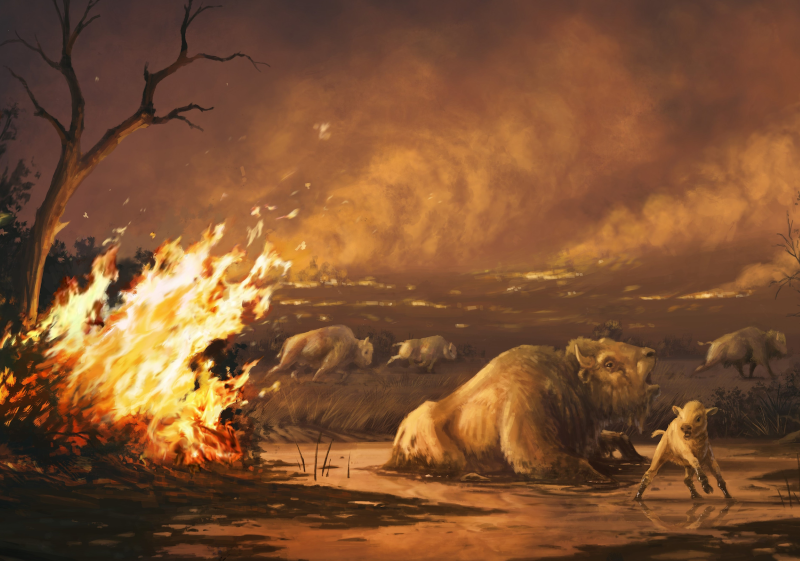
Large-scale wildfires during a period of climate change that contributed to the extinction of a wide range of critically important species? In the fragile, fragmented Santa Monica Mountains where wildfires are increasingly common, and species like the mountain lion are already on the edge of local extinction, this scenario is a major concern. Now new evidence suggests it’s happened before, right here,13,000 years ago.
A new study authored by researchers at La Brea Tar Pits was recently published in the journal Science, suggests that mega wildfires—some of them possibly started by humans—may have caused the extinction of Southern California’s Ice Age megafauna, including two of this areas most legendary apex predators: saber-toothed cats and dire wolves.
The researchers used a new radiocarbon dating method developed specifically for fossils preserved in asphalt to determine the age of 169 fossils from eight large mammal species, including saber-toothed cats, dire wolves, American lions, ground sloths, extinct horses and bison, camels, and coyotes.
The fossil record at the tar pits is unique because it comprises hundreds, and in some cases thousands, of animals of various species like saber-toothed cats, dire wolves, and horses. The new radiocarbon data revealed that the collection also includes the last known living individual of five of these species from anywhere on the continent. The ability to accurately determine when the different species vanished from the ecosystem opened up an entirely new theory into this extinction event.

The researchers compared the radiocarbon dates to regional pollen and charcoal records and continent-wide data on human and large mammal populations and used the correlation to develop, “the first statistical modeling of extinction causality in southern California,” the paper states. The models produced the most detailed chronology to date, showing the relationship between climate and vegetation change, fire activity, human demographics, and megafauna extinctions.
The fossils indicated that all megafauna species dated other than the coyotes were extinct by 12,900 years ago. “That is more than a hundred years before the sudden cold snap known as the Younger Dryas, which has often been invoked as a potential cause of the extinctions,” the researchers wrote. ”The findings also rule out a hypothetical comet impact that some scientists had proposed as a cause of both the Younger Dryas and the extinctions, as well as overhunting by the hunter-gatherer Clovis culture, which largely post-dated the La Brea megafauna disappearance.”
Instead, the study lays out a disastrous chain of ecological events reconstructed from climate, vegetation, and fire records preserved in the sediments of nearby Lake Elsinore. “It started with the gradual warming and drying of the landscape and a simultaneous decline in forest-adapted large herbivores over 2,000 years, as Earth emerged from the last Ice Age and glaciers receded. Then, just as human populations began to sharply increase in North America, the ecosystem underwent a dramatic change: temperatures rose rapidly, a 200-year-long drought parched the landscape, and massive wildfires transformed plant communities. Within 300 years, all the Ice Age giants at La Brea were gone, and California’s modern, fire-adapted chaparral ecosystem had appeared.”
“The vast collection of Ice Age fossils in Los Angeles opens a unique window on the timing and dynamics of large mammal extinction in Southern California,” said Robin O’Keefe, Professor, Biological Sciences at Marshall University and lead author.
“This is the first time that we’ve been able to link specific changes in the climate and vegetation to specific changes in megafaunal populations,” says co-author Dr. Regan Dunn, a paleobotanist and Interim Assistant Deputy Director and Assistant Curator at La Brea Tar Pits. “The research shows that rapid warming and drying paved the way for a dramatic ecosystem shift from a woodland environment to a drier system that human-sparked fires transformed into the chaparral ecosystems we know today.”
The research offers a stark warning to the current inhabitants of the Los Angeles Basin: learn from history or repeat it.
“The conditions that led to the terminal-Pleistocene state shift in southern California are recurring today in the western USA and in numerous other ecosystems worldwide,” the researchers wrote. “Understanding the interplay of climatic and anthropogenic changes in driving this past extinction event may be helpful in mitigating future biodiversity loss in the face of similar pressures.”
Pre–Younger Dryas megafaunal extirpation at Rancho La Brea linked to fire-driven state was authored by F. Robin O’Keefe, Regan E. Dunn, Elic M. Weitzel, Michael R. Waters, Lisa N. Martinez, Wendy J. Binder, John R. Southon, Joshua E. Cohen, Julie A. Meachen, Larisa R. G. DeSantis, Matthew E. Kirby, Elena Ghezzo, Joan B. Coltrain, Benjamin T. Fuller, Aisling B. Farrell, Gary T. Takeuchi, Glen MacDonald, Edward B. Davis, and Emily L. Lindsey and was published in Science on August 17, 2023.
Learn more at tarpits.org




